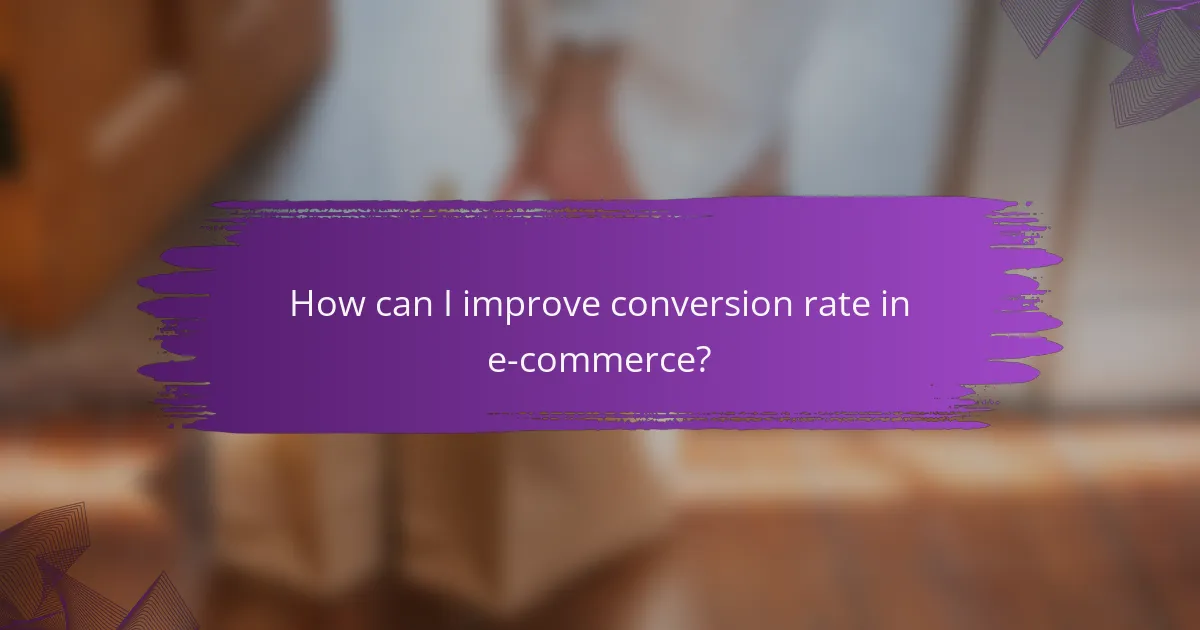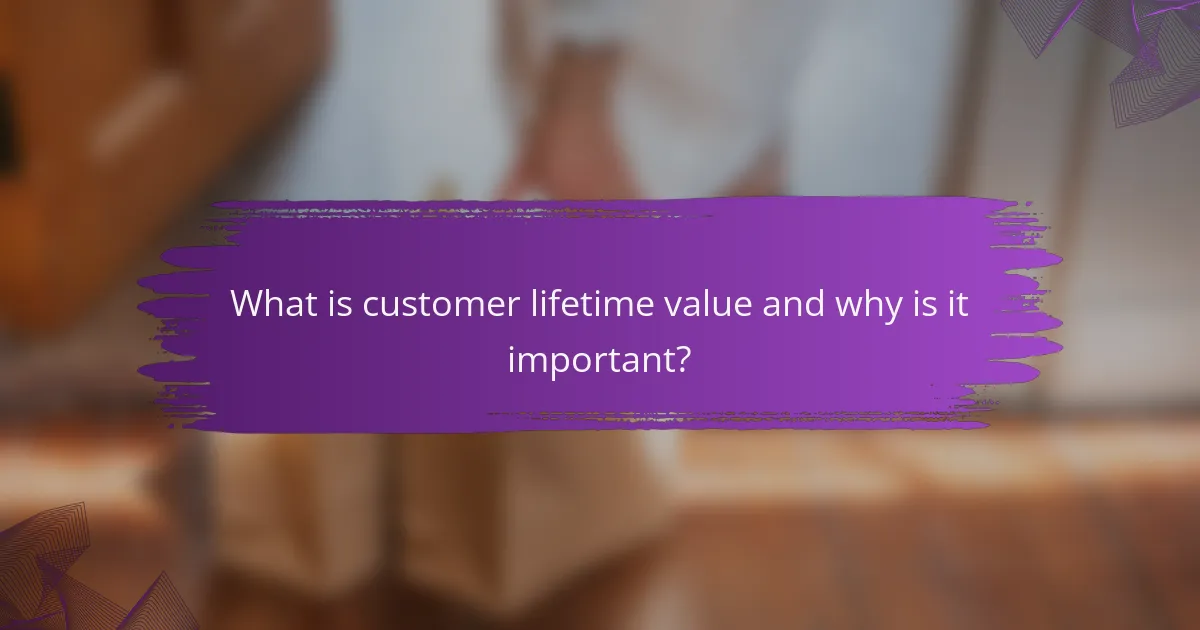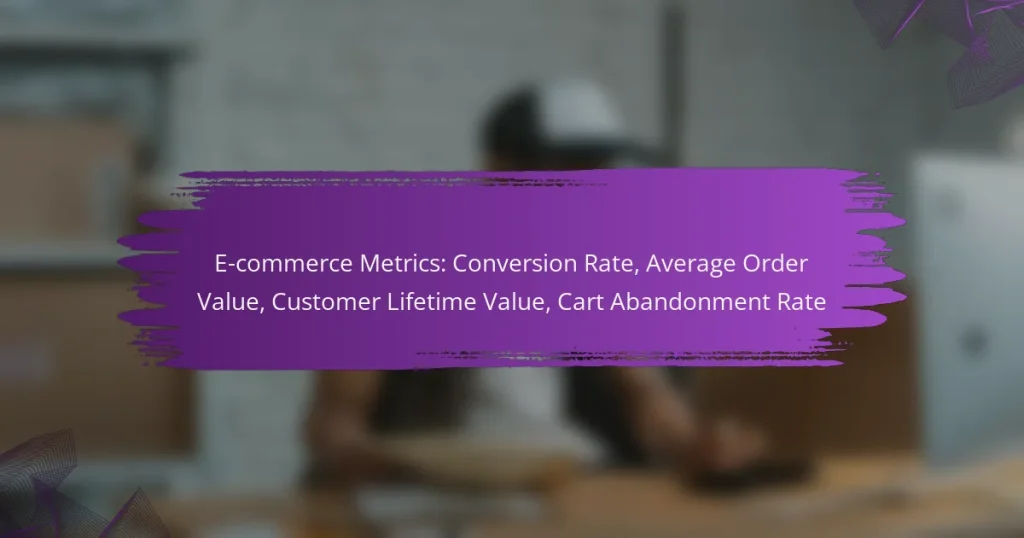In the competitive world of e-commerce, understanding key metrics such as conversion rate, average order value, customer lifetime value, and cart abandonment rate is essential for driving business success. These metrics provide valuable insights into customer behavior and purchasing patterns, enabling businesses to optimize their strategies and enhance the shopping experience. By focusing on these areas, e-commerce retailers can improve profitability and foster long-term customer relationships.

How can I improve conversion rate in e-commerce?
Improving the conversion rate in e-commerce involves optimizing various aspects of your online store to encourage visitors to complete purchases. Key strategies include enhancing website design, product descriptions, and the checkout process, as well as leveraging social proof and A/B testing.
Optimize website design
A well-designed website can significantly boost conversion rates. Focus on creating a clean, user-friendly layout that guides visitors seamlessly through the shopping experience. Ensure that your site is mobile-responsive, as a large portion of online shopping occurs on smartphones.
Consider using high-quality images, clear navigation menus, and a consistent color scheme to enhance visual appeal. Avoid clutter and distractions that may divert attention from the products you are selling.
Enhance product descriptions
Effective product descriptions can persuade potential buyers to make a purchase. Use clear, concise language that highlights the benefits and features of each product. Incorporate keywords that customers might use when searching for your items to improve search visibility.
Including customer reviews or testimonials within the descriptions can also enhance credibility and encourage conversions. Use bullet points for key features to make the information easily digestible.
Implement A/B testing
A/B testing allows you to compare two versions of a webpage to determine which one performs better in terms of conversion rates. Test different elements such as headlines, images, and call-to-action buttons to see what resonates most with your audience.
Make sure to run tests for a sufficient duration to gather meaningful data and avoid making decisions based on temporary fluctuations. Use analytics tools to track performance and make data-driven adjustments.
Utilize social proof
Social proof, such as customer reviews, ratings, and testimonials, can significantly influence purchasing decisions. Displaying positive feedback prominently on product pages can reassure potential buyers about the quality of your offerings.
Consider integrating user-generated content, such as photos or videos from customers using your products, to create a sense of community and trust. Highlighting any awards or recognitions can also enhance credibility.
Streamline checkout process
A complicated checkout process can lead to cart abandonment and lost sales. Simplify the steps required to complete a purchase by minimizing the number of fields customers need to fill out and offering guest checkout options.
Ensure that the checkout page is secure and clearly communicates shipping costs and delivery times upfront. Providing multiple payment options, including popular digital wallets, can also enhance the user experience and improve conversion rates.

What is the average order value and how can I increase it?
The average order value (AOV) is a key e-commerce metric that indicates the average amount spent by customers per transaction. To increase AOV, businesses can implement various strategies that encourage customers to spend more during their shopping experience.
Definition of average order value
Average order value is calculated by dividing total revenue by the number of orders over a specific period. This metric helps businesses understand customer spending habits and can guide pricing and marketing strategies. A higher AOV typically indicates effective sales tactics and customer engagement.
Strategies to increase average order value
To boost average order value, consider implementing minimum purchase incentives, such as offering free shipping on orders over a certain amount. Additionally, creating bundled products can encourage customers to buy more items at a perceived discount. Regularly analyzing customer behavior can also provide insights into effective pricing strategies.
Cross-selling and upselling techniques
Cross-selling involves suggesting complementary products to customers, while upselling encourages them to purchase a more expensive version of the item they are considering. For example, if a customer is buying a camera, suggesting a lens or a carrying case can enhance their purchase. Implementing these techniques through personalized recommendations on product pages or during checkout can significantly increase AOV.

What is customer lifetime value and why is it important?
Customer lifetime value (CLV) is a metric that estimates the total revenue a business can expect from a single customer throughout their relationship. Understanding CLV is crucial as it helps businesses make informed decisions about marketing spend, customer acquisition strategies, and overall growth potential.
Definition of customer lifetime value
Customer lifetime value represents the projected revenue that a customer will generate during their entire time as a paying client. It typically considers factors such as purchase frequency, average order value, and customer retention duration. Businesses often calculate CLV to assess the long-term value of acquiring new customers versus the costs involved.
Factors affecting customer lifetime value
Several factors influence customer lifetime value, including customer acquisition costs, retention rates, and the average transaction value. For instance, a business with high customer retention and frequent purchases will generally see a higher CLV. Additionally, the effectiveness of marketing strategies and customer service quality can significantly impact how long customers stay and how much they spend.
Other elements like customer demographics and purchasing behavior also play a role. For example, customers in certain age groups or income brackets may have different spending habits, which can affect their overall lifetime value to the business.
Importance of customer retention
Customer retention is vital for maximizing customer lifetime value, as retaining existing customers is often more cost-effective than acquiring new ones. Businesses that focus on building strong relationships with their customers can enhance loyalty, leading to repeat purchases and referrals. A small increase in retention rates can result in significant revenue growth over time.
Moreover, satisfied customers are likely to spend more and may even become brand advocates. Implementing loyalty programs, personalized marketing, and excellent customer service are effective strategies to improve retention and, consequently, customer lifetime value.

How can I reduce cart abandonment rate?
Reducing cart abandonment rate involves understanding why customers leave without completing their purchases and implementing strategies to encourage them to finalize their transactions. By addressing common pain points and enhancing the shopping experience, you can significantly lower abandonment rates.
Identify common reasons for cart abandonment
Understanding the reasons behind cart abandonment is crucial for effective intervention. Common factors include unexpected shipping costs, complicated checkout processes, and lack of payment options. Surveys or analytics tools can help identify specific issues affecting your customers.
Additionally, consider the timing of your checkout process. If it takes too long or requires excessive information, customers may lose interest. Regularly reviewing and optimizing your checkout flow can lead to improvements.
Implement exit-intent popups
Exit-intent popups can capture customers’ attention just as they are about to leave your site. These popups can offer discounts, remind users of their cart contents, or provide additional information that may persuade them to stay. Timing and relevance are key to making these popups effective.
Ensure that the popups are not intrusive and can be easily dismissed. A well-designed exit-intent popup can reduce abandonment rates by offering immediate value to the customer, such as a limited-time discount or free shipping on their order.
Offer free shipping options
Free shipping is a powerful incentive that can significantly reduce cart abandonment. Many customers abandon their carts due to high shipping costs, so consider offering free shipping on orders above a certain threshold or during promotional periods. This strategy not only encourages larger purchases but also enhances customer satisfaction.
Be transparent about shipping costs early in the shopping process to avoid surprises at checkout. Clearly displaying free shipping thresholds can motivate customers to add more items to their cart to qualify.
Enhance mobile experience
With a growing number of consumers shopping on mobile devices, optimizing the mobile experience is essential for reducing cart abandonment. Ensure your website is mobile-friendly, with a responsive design that allows for easy navigation and quick loading times.
Simplify the checkout process for mobile users by minimizing the number of steps required to complete a purchase. Consider implementing features like autofill for forms and mobile payment options to streamline the experience and encourage conversions.

What metrics should I track for e-commerce success?
To achieve e-commerce success, track key metrics such as conversion rate, average order value, customer lifetime value, and cart abandonment rate. These metrics provide insights into customer behavior and overall business performance, helping you make informed decisions.
Key performance indicators for e-commerce
Key performance indicators (KPIs) for e-commerce include conversion rate, which measures the percentage of visitors who make a purchase, and average order value (AOV), indicating the average amount spent per transaction. Customer lifetime value (CLV) estimates the total revenue a customer generates throughout their relationship with your business, while cart abandonment rate tracks the percentage of shoppers who leave items in their cart without completing the purchase.
For example, a conversion rate of 2-5% is typical for many online stores, while an AOV can vary widely depending on the industry, often ranging from $50 to $200. Understanding these KPIs helps identify areas for improvement, such as optimizing product pages or enhancing the checkout process.
Importance of analytics tools
Analytics tools are crucial for tracking e-commerce metrics effectively. They provide real-time data on user behavior, allowing you to analyze trends and make data-driven decisions. Popular tools like Google Analytics or specialized e-commerce platforms can help you monitor KPIs and generate reports.
Utilizing analytics tools enables you to set benchmarks and track progress over time. For instance, if your cart abandonment rate is above 70%, you may want to investigate potential issues in your checkout process. Regularly reviewing analytics can help you adapt your strategies to improve overall performance and customer satisfaction.


